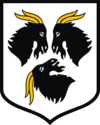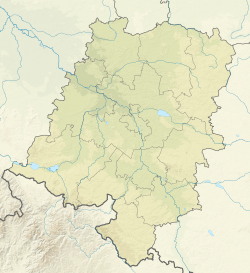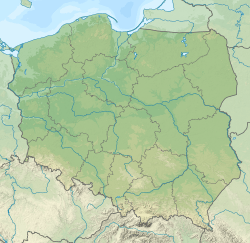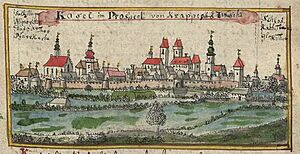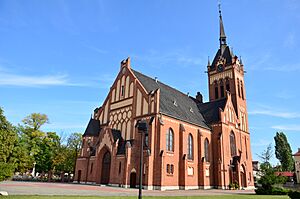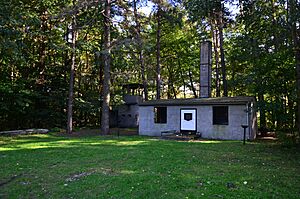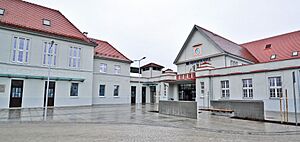Kędzierzyn-Koźle facts for kids
Quick facts for kids
Kędzierzyn-Koźle
|
|||
|---|---|---|---|
|
|||
|
|||
| Country | |||
| Voivodeship | |||
| County | Kędzierzyn-Koźle County | ||
| Gmina | Kędzierzyn-Koźle (urban gmina) | ||
| Area | |||
| • Total | 123.42 km2 (47.65 sq mi) | ||
| Elevation | 180 m (590 ft) | ||
| Population
(31 December 2021)
|
|||
| • Total | 58,899 |
||
| Time zone | UTC+1 (CET) | ||
| • Summer (DST) | UTC+2 (CEST) | ||
| Postal code |
47-200, 47-220, 47-232
|
||
| Vehicle registration | OK | ||
| City districts | Azoty, Blachownia Śląska, Cisowa, Kędzierzyn, Koźle, Koźle Port, Koźle Rogi, Kłodnica, Kuźniczka, Lenartowice, Miejsce Kłodnickie, Sławięcice | ||
| Highways | |||
| National roads | |||
| Voivodeship roads | |||
| Website | http://www.kedzierzynkozle.pl | ||
Kędzierzyn-Koźle is a city in southern Poland. It is the main town of Kędzierzyn-Koźle County. As of 2021, about 58,899 people live there. This makes it the second largest city in the Opole Voivodeship region.
Contents
Location and Economy
Kędzierzyn-Koźle is in the historic Silesia region. It sits where the Oder River meets the Kłodnica River. The city is also on the Gliwice Canal. This location makes it a major river port.
It has good train links to other big cities in Poland. The city is also known for its chemical industry. There are several factories and a power plant in the Blachownia Śląska area. One of Poland's biggest chemical plants, Zakłady Azotowe Kędzierzyn, is located here.
In 1975, the old town of Koźle joined with other nearby towns. These included Kędzierzyn, Sławięcice, and Kłodnica. They had grown into suburbs because of industry in the 1800s. Together, they formed the Kędzierzyn-Koźle we know today.
City Name and Meaning
The name Kędzierzyn-Koźle comes from Polish words. Kędzierzyn might come from a name like Kędziora. Koźle means "he-goat" or "buck".
The city's coat of arms shows three goat heads. This is a special kind of symbol that relates to the city's name.
History of the City
Early History of Koźle
Koźle was first mentioned in 1104 as a border fortress. It was part of the Polish Duchy of Silesia. Later, it became part of the Duchy of Racibórz. In 1281, Duke Casimir of Bytom took over Koźle. He made it a town with special rights in 1293 and built walls around it.
A monastery was founded in Koźle in 1431. The town remained an important place for many years.
Wars and Changes
Koźle faced many attacks during the Thirty Years' War. It was taken by Danish and Swedish troops at different times. The town was almost completely destroyed by these conflicts. In 1645, it returned to Polish rule.
In 1742, Koźle became part of Prussia. The king ordered the city's defenses to be made stronger. Even so, it was attacked again during other wars. The fortress in Koźle was very strong. It held out against attacks during the Seven Years' War.
In 1807, the Prussian soldiers in Koźle defended the city against French and Bavarian forces. They held out until a peace treaty was signed. In 1815, Koźle became part of the Prussian province of Silesia.
The city grew thanks to the Kłodnica Canal. This canal connected the Oder port to Gliwice. It was built between 1806 and 1907. In 1903, a Polish bank called Bank Ludowy was started in Koźle.
After World War I, there was a vote in the region. Polish people living there tried to take control of parts of the town. They captured supplies and trains. However, Koźle remained part of Germany. Polish people living there faced difficulties from 1937 onwards.
During World War II, the Germans set up several camps in the town. These were camps where prisoners of war and others were forced to work. After the war, in 1945, Koźle became part of Poland again.
Kędzierzyn and Other Areas
Kędzierzyn was founded as a village in the 1200s. Sławięcice was also mentioned around that time. Both were part of Poland. Sławięcice even had town rights for a short time.
During the Third Silesian Uprising in 1921, Polish people fought against German forces. They captured Sławięcice, Blachownia Śląska, Cisowa, Kędzierzyn, and Kłodnica. Sławięcice became an important place for the Polish fighters. It had a hospital and a command center. Later, the Germans took Kędzierzyn back. They also harmed Polish prisoners in a nearby area.
During World War II, the Germans ran many camps in the area. These were places where people were forced to work. There were camps in Kędzierzyn, Blachownia Śląska, Kłodnica, and Sławięcice. People from different countries, including Allied prisoners of war, Jewish people, and Polish children, were held in these camps. In Sławięcice, there was a building that served as a crematorium for victims of the camps. Today, it is a memorial. Towards the end of the war, thousands of prisoners were forced to march through Blachownia and Koźle.
After Germany lost the war, the region became part of Poland. Many German people moved to new homes. Polish people from other parts of Poland, including those who had to leave their homes in the east, came to live in Kędzierzyn-Koźle. Some Poles also returned from Romania.
In 1954, Blachownia and Lenartowice joined to form the Blachownia Śląska district. In 1999, a train line connecting the city to Strzelce Opolskie was closed.
Sports
Kędzierzyn-Koźle is home to ZAKSA Kędzierzyn-Koźle. This is a very successful Polish volleyball club. They have won the Polish Championship nine times. They have also won the Polish Cup ten times. The team has won the CEV Champions League three times (in 2021, 2022, and 2023).
Transportation
The city has five railway stations. Kędzierzyn-Koźle is located where several important roads meet. These include National road 40 and Voivodeship roads 408, 410, 418, 423, and 426. The A4 motorway also runs close to the city, just north of it.
Famous People
- Tomasz Kamusella (born 1967), a Polish scholar
- Ewa Komander (born 1985), a Polish triathlete
- Kamil Semeniuk (born 1996), a Polish volleyball player
- Rafał Wojaczek (1945–1971), a Polish poet
Sister Cities
Kędzierzyn-Koźle has special friendships with other cities around the world. These are called sister cities:
 Jonava, Lithuania
Jonava, Lithuania Kalush, Ukraine
Kalush, Ukraine Öhringen, Germany
Öhringen, Germany Pisz, Poland
Pisz, Poland Přerov, Czech Republic
Přerov, Czech Republic Racibórz, Poland
Racibórz, Poland
See also
 In Spanish: Kędzierzyn-Koźle para niños
In Spanish: Kędzierzyn-Koźle para niños









